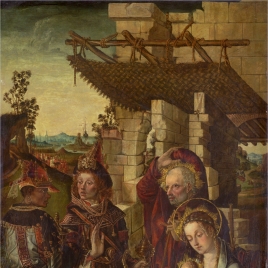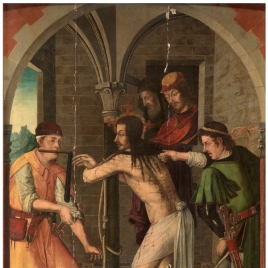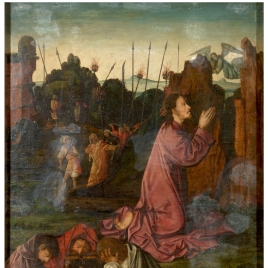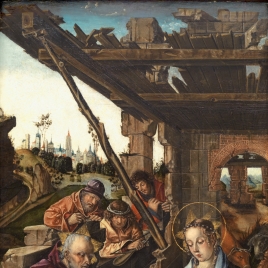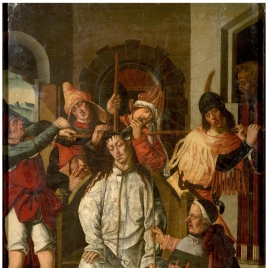Cargando ...
Explore the collection
Artist
Oil on panel. 1490
Osona, Francisco de ; Osona, Rodrigo de
This and five other panels at the Prado Museum (P6897, P6898, P6899, P6900, P6901), are some of the finest examples of the collaboration between Rodrigo and Francisco de Osona. They were probably designed as part of an altarpiece. The placement and physiognomy of the figures are in keeping with the style of this family of painters from Valencia. The diverse treatment of the paintings suggests the
Oil on panel. 1490
Osona, Francisco de ; Osona, Rodrigo de
The Virgin Mary sits beside Saint Joseph, holding the newborn Jesus in her lap, while king Melchior kisses the baby´s foot and Casper and Balthasar place their presents on a tray. The idyllic landscape and the architecture typical of northern European cities, as well as the composition, bluish-grey color scheme and hieratic figures clothed in robes with stiff folds, recall the Spanish-Flemish styl
Oil on panel. 1490
Osona, Francisco de ; Osona, Rodrigo de
Executed with considerable participation from Rodrigo’s son Francisco Osona, this panel’s composition derives from an engraving by Martin Schongauer. The grotesque figure of the torturer holding the rope around Christ is counterbalanced by the sumptuous Granadan textiles behind Pilate, decorated with bands, geometrical motifs and inscriptions. The result is another example of the varied artistic u
Oil on panel. Ca. 1490
Osona, Francisco de ; Osona, Rodrigo de
This and five other panels at the Prado Museum (P06897, P06898, P06900, P06901, P06902), are some of the finest examples of the collaboration between Rodrigo and Francisco de Osona. They were probably designed as part of an altarpiece. The placement and physiognomy of the figures are in keeping with the style of this family of painters from Valencia. The diverse treatment of the paintings suggests
Pontius Pilate Washing his Hands
Oil on panel. Ca. 1490
Osona, Francisco de ; Osona, Rodrigo de
This and five other panels at the Prado Museum (P06897, P06899, P06900, P06901, P06902), are some of the finest examples of the collaboration between Rodrigo and Francisco de Osona. They were probably designed as part of an altarpiece. The placement and physiognomy of the figures are in keeping with the style of this family of painters from Valencia. The diverse treatment of the paintings suggests
Oil on panel. Ca. 1490
Osona, Francisco de ; Osona, Rodrigo de
This and five other panels at the Prado Museum (P06897,P06898 , P06899, P06901, P06902), are some of the finest examples of the collaboration between Rodrigo and Francisco de Osona. They were probably designed as part of an altarpiece. The placement and physiognomy of the figures are in keeping with the style of this family of painters from Valencia. The diverse treatment of the paintings suggests
Oil on panel. 1490
Osona, Francisco de ; Osona, Rodrigo de
The Virgin Mary and Saint Joseph kneel in prayer beside the newborn Jesus. They are accompanied by three angels who arrange the Child´s swaddling clothes. Three Shepherds look in from outside the ruins of the doorway. An ox and a mule occupy the background. The idyllic landscape and the architecture typical of northern European cities, as well as the composition, bluish-grey color scheme and hiera
Oil on panel. Ca. 1500
Osona, Francisco de ; Osona, Rodrigo de
This and five other panels at the Prado Museum (P06897, P06898, P06899, P06900, P06902), are some of the finest examples of the collaboration between Rodrigo and Francisco de Osona. They were probably designed as part of an altarpiece. The placement and physiognomy of the figures are in keeping with the style of this family of painters from Valencia. The diverse treatment of the paintings suggests
Loading...


